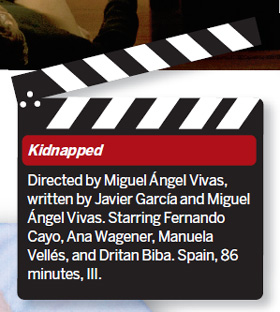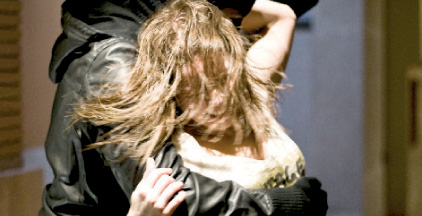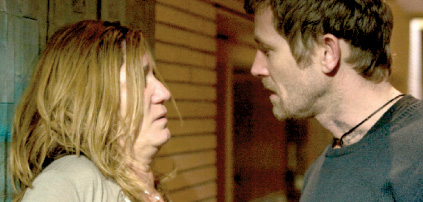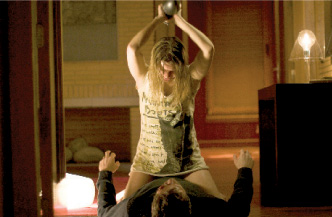Captive audiences
Updated: 2011-05-28 06:41
By Elizabeth Kerr(HK Edition)
|
|||||||


Technical virtuosity no match for gruesome action in home invasion thriller. Elizabeth Kerr reports.
Filmmakers with few resources and fewer dollars have, always been saddled with the obligation to make their work stand apart from the crowd without any bells and whistles to help get noticed. One of the best ways to get attention is also one of the oldest: manipulating the medium and inventing or reinterpreting film language. It's not a new concept - way back in the 1920s Sergei Eisenstein was redefining editing, followed by Jean-Luc Godard in the 1950s - and playing with the form's most basic building blocks has proven to be a most effective method of being heard. The darling of this year's Cannes Film Festival was Michel Hazanavicius' The Artist, a black-and-white, silent slice of feel-good showbiz nostalgia.
Film and technology have gone hand in hand since the birth of the movies, and the industry has rarely experienced technical stagnancy. Sound was a gadget. So was color. 70mm widescreen tools were once a fad, as was 3D (the first time around), and hard drive editing, CGI and IMAX were experiments that managed to prove their worth. There is a reason the Academy gives out scientific Oscars each year.
With modern 3D (bias alert: I have seen 2 films post-Avatar that justify the discomfort of the glasses and resulting headache) the dominant force, though a waning one if Pirates of the Caribbean's first weekend 3D grosses are a harbinger, filmmakers are once again making technical creativity a selling point. The most fundamental equipment - the camera - is being rediscovered. Again, this isn't new: in 1948 Alfred Hitchcock forced viewers to rethink the marriage of photography and editing in Rope; '58 gave us the ultimate tracking shot in Orson Welles' Touch of Evil; the interim has seen Martin Scorsese, Robert Altman, Paul Thomas Anderson, and Alfonso Cuaron among others use that long tracking shot as a virtuoso establishing device. Sure, there may be cheaters in there, but it looks great nonetheless. It also efficiently and immediately telegraphs a filmmaker's intention to surprise us.
That old-fashioned camera appreciation really cemented itself when The Blair Witch Project became the de facto MO for horror in the wake of its massive success. The whole hand held/long take/found footage gimmick has very nearly become a convention of thrillers and sci-fi, but it is still most influential in horror (Cloverfield, Paranormal Activity, Insidious) and Uruguayan director Gustavo Hernndez's The Silent House, allegedly filmed in one long, 78-minute take.
Take all those factors and put them in a blender with the burgeoning Euro-horror trend that revels in nihilism (almost as intensely as American horror honed the backwoods brutality/torture porn sub-genre) in films like The Orphanage, Martyrs, the underrated zombie chiller [REC], Dead Snow, a touch of 1970s Peckinpah-esque vigilante rage, and a dash of middle-class paranoia and you will come up with something like Kidnapped.
Co-writer and director Miguel ngel Vivas' Kidnapped is a visceral home invasion thriller that goes to great pains to put the audience in the middle of the terror. Composed of perhaps a dozen long takes, using largely natural light and split screens, and purely ambient music, it is a technical marvel to be sure - a hybrid of verit documentary and action-horror. Vivas' camera rarely flinches away from even the most discomfiting of moments and the split screens provide key juxtapositions of simultaneous action happening in two separate spaces without breaking up the flow of either. There's a slow ratcheting up of tension thanks to generally strong performances by the cast and the film tightens its gruesome grip as the minutes tick by. A prime example is the agonizing sequence where an invader wedges himself between two hostages on the couch to enjoy some television. Vivas' camera puts us there too, and it's supremely nasty.
We're introduced to an affluent Spanish family as they move to the suburbs. Marta (Ana Wagener, Biutiful) is the vaguely demanding mother of typically obnoxious teenager Isa (Manuela Vells) and wife to the passive, enabling Jaime (Fernando Cayo, The Orphanage). Isa wants to go to a party with her friends, Marta wants her to christen the family abode with dinner at home and Jaime does his best to appease them both. In other words a typical modern family. Just as Marta is finishing dinner and Isa is getting dressed, three masked men break in and proceed to torture, humiliate, and terrorize the three for a long, hideous night of violence. As if that weren't enough, it gets even worse right at the end.
Vivas' crutch is the notion that there is something inherently profane about having one's safe haven - one's home - despoiled. And he does a pretty good job with the "You Are There" tone for most of the film by working tried and true Filmmaking 101 skills. But then a funny thing happens: Kidnapped becomes so overwhelmed by the violence Vivas is "condemning" it turns into an exploitive free-for-all that is as exhausting as it is ugly. All the gut-wrenching tension built up in the first hour starts to crumble in the face of gleefully vicious detail. When Dritan Biba's Albanian gang leader takes Jaime to max out the family's credit cards, he leaves unhinged fellow Albanian drug addict (Martijn Kuiper) and impotent local hood (Guillermo Barrientos) behind with the women. Do you think something could possibly go wrong there is he goes off book?
Vivas claims his thugs were Albanian for veracity ("I decided it would be unfair not to portray the reality of the situation, since the majority of violent raids are produced by people from Eastern Europe," he stated) but the delicate race-baiting combined with outrageous violence directed at women, Vells' tiresome hysterical hyperventilating that marginalizes her ordeal, and the bleakest conclusion imaginable (one that slaps the audience upside the head for "identifying" with the characters) makes the clear technical prowess moot in the end. When Kidnapped is relatively quiet, it does indeed make for one of the most harrowing film experiences of the last decade. When it illustrates why, it devolves into pointlessly sickening clich. For cinema students only.
Kidnapped opened in Hong Kong on Thursday.
|
A simple home invasion and robbery turns into a night of terror in the visceral, cleverly produced Kidnapped, the latest in modern horror from Spain. |
|
Marta (Ana Waganer) tries to protect her daughter from an unhinged invader (Martijn Kuiper) in Miguel angel Vivas' Kidnapped. |
|
Enough is enough for teenaged Isa (Manuela Velles) in Kidnapped. |
(HK Edition 05/28/2011 page4)


